Recycled Chicken Feather Sand as a Partial Replacement for Natural Sand for Producing Eco-Friendly Mortar
Abstract
:1. Introduction
2. Research Significance
- The significance of this research lies in the analysis of chicken feather waste, which has never been thoroughly investigated.
- Use of CFS as a partial replacement for natural sand in the production of eco-friendly mortar (GM).
- Further research is being conducted on the use of CFS as a partial replacement for sand in the eco-friendly mortar industry.
- Eco-friendly mortar production with varying levels of CFS achieved a compressive strength of 57.8 MPa after 28 days.
- Exploring the impact of CFS on the microstructure of eco-friendly mortar (GM), as well as its new and mechanical properties.
3. Experimental Program
3.1. Materials Used and Their Properties
- Cement: All mortar combinations were made using standard Portland cement CEM I 42.5 (Asyut cement), which complies with ECP 203.
- Fine aggregate: Local sand was used as the fine aggregate. The sand used is of medium quality. Figure 1 depicts the grain size distribution for CFS, natural sand, and the fine aggregate used in this experiment. The fine aggregate utilized in this experiment was natural siliceous sand, a clean and rounded fine aggregate with a size of 0.5 mm, a specific gravity of 2.66, a unit weight of 1680 kg/m3, and a fineness modulus of 2.75.
- Water: Potable water was used.
3.2. Chicken Feather Sand
Proportion of Chicken Feather Sand
4. Mix Design Proportions
5. Testing Procedure
6. Test Results and Discussions
6.1. Fresh Properties
6.2. Hardened Properties
6.3. Surface Morphology
6.4. Comparison between Natural Sand Mortar and Chicken Feather Sand Mortar Cost
7. Conclusions
- A high replacement ratio requires the use of more water to obtain a particular consistency, and more water is required to maintain that consistency.
- The compressive strength and unit weight relationship is proportional, which means that the greater the compressive strength, the lower the weight at the replacement ratio CFS-10%, and the lower the compressive strength, the lower the weight after the replacement ratio CFS-10%.
- As water absorption increases, CFS replacement also increases; water absorption was higher in the CFS-25% mixture.
- The replacement of CFS-10% as the optimal replacement ratio resulted in compressive strength values of 41.58 MPa at 7 days and 57.8 MPa at 28 days.
- As may be observed from the findings of this research, the usage of CFS significantly improves the flexural strength by replacement ratios of 5%, 10%, and 15% of CFS; however, mechanical properties were lowered in the study after replacement ratios of 20%.
- The surfaces of the CFS-5%, CFS-10%, and CFS-15% mixtures were rigid and nonporous, but the surfaces of the CFS-20% and CFS-25% mixtures were porous. This rigid surface may contribute to more strength, but the porous surface has less strength due to the dispersive structure.
- Regarding the costs, the optimum replacement is 10%, which decreases the cost of 1 m3 of mortar by 3.0% while increasing its strength.
Author Contributions
Funding
Institutional Review Board Statement
Informed Consent Statement
Data Availability Statement
Conflicts of Interest
References
- Pavithra, C.; Arpan Maheshwari, A.A. Behaviour of concrete adding chicken feather as fibre with partial replacement of cement with Cashewnut shell powder. Mater. Today Proc. 2020, 43, 1173–1178. [Google Scholar] [CrossRef]
- Pasupathy, K.; Ramakrishnan, S.; Sanjayan, J. Formulating eco-friendly geopolymer foam concrete by alkali-activation of ground brick waste. J. Clean. Prod. 2021, 325, 129180. [Google Scholar] [CrossRef]
- Farming, C.I.W. Statistics: Broiler Chickens. 2013. Available online: www.ciwf.org (accessed on 6 October 2022).
- Xin-gang, Z.; Yuan-feng, Z.; Yan-bin, L. The spillovers of foreign direct investment and the convergence of energy intensity. J. Clean. Prod. 2019, 206, 611–621. [Google Scholar] [CrossRef]
- Karani, P.; Jewasikiewitz, S.M. Waste management and sustainable development in South Africa. Environ. Dev. Sustain. 2007, 9, 163–185. [Google Scholar] [CrossRef]
- Sabapathy, K.A.; Gedupudi, S. On the influence of concrete-straw-plaster envelope thermal mass on the cooling and heating loads for different climatic zones of India. J. Clean. Prod. 2020, 276, 123117. [Google Scholar] [CrossRef]
- Sudalaiyandi, G. Characterising the Cleaning Process of Chicken Feathers. Ph.D. Thesis, Waikato University, Hamilton, New Zealand, 2012. [Google Scholar]
- Kock, J.W. Physical and Mechanical Properties of Chicken Feather Materials. Master’s Thesis, Georgia Institute of Technology, Atlanta, GA, USA, 2006. [Google Scholar]
- Gupta, A.; Kamarudin, N.B.; Kee, C.Y.G.; Yunus, R.B.M. Extraction of Keratin Protein from Chicken Feather; University of Malaysia Pahang: Pahang, Malaysia, 2011; pp. 2200–2209. [Google Scholar]
- Frazer, L. Chicken Electronics: A Technology Plucked from Waste. Environ. Health Perspect. 2004, 112, A565–A567. [Google Scholar] [CrossRef]
- Kondratyev, K.Y.; Galindo, I. Global climate change in the context of global ecodynamics. Geofis. Int. 1994, 3, 487–496. [Google Scholar] [CrossRef]
- Ramesh, T.; Prakash, R.; Shukla, K.K. Life cycle energy analysis of buildings: Anoverview Energy Build. CMB 2010, 42, 1592–1600. [Google Scholar]
- Raut, S.P.; Ralegaonkar, R.V.; Mandavgane, S.A. Development of sustainable construction material using industrial and agricultural solid waste: A review of waste-create bricks. Constr. Build. Mater. 2011, 25, 4037–4042. [Google Scholar] [CrossRef]
- Gowsika, D.; Sarankokila, S.; Sargunan, K. Experimental Investigation of Egg Shell Powder as Partial Replacement with sand. Int. J. Eng. Trends Technol. 2014, 14, 65–68. [Google Scholar] [CrossRef]
- Ako, T.A.; Onoduku, U.S.; Oke, S.A.; Essien, B.I.; Idris, F.N.; Umar, A.N.; Ahmed, A.A. Environmental Effects of Sand and Gravel Mining on Land and Soil in Luku, Minna Niger State, North Central Nigeria. J. Geosci. Geomat. 2014, 2, 42–49. [Google Scholar]
- Sharma, A.K. Chicken feather as a substitute of fine aggregate in mortar. Int. J. Adv. Eng. Sci. Res. 2016, 3, 35–48. [Google Scholar]
- Binici, H.; Aksogan, O.; Sevinc, A.H.; Cinpolat, E. Mechanical and radioactivity shielding performances of mortars made with cement, sand and eggshells. Constr. Build. Mater. 2015, 93, 1145–1150. [Google Scholar] [CrossRef]
- Thirumurugan, V.; Raj, S.G.V.; Dheenadhayalan, K. Experimental Study on Strength of Mortar by Partial Replacement of Cement by Cashew Nut Shell Ash (CNSA) and Chicken Feather Fiber (CFF) as Fiber Reinforcement. Int. J. Adv. Res. Ideas Innov. Technol. 2018, 3, 110–119. [Google Scholar]
- Barone, J.R. Polyethylene/Keratin Fiber Composites with Varying Polyethylene Crystalline. Compos. Part A Appl. Sci. Manuf. 2005, 36, 1518–1524. [Google Scholar] [CrossRef]
- Barone, J.R.; Schmidt, W.F. Polyethylene Reinforced with Keratin Fibers Obtained from Chicken Feather. Compos. Sci. Technol. 2005, 65, 173–181. [Google Scholar] [CrossRef]
- Hamoush, S.A.; El-Hawary, M.M. Feather Fiber Reinforced Concrete. Mortar Int. 2016, 16, 33–35. [Google Scholar]
- Parkinson, G. Chementator: A Higher Use for Lowly Chicken Feathers? Chem. Eng. 2015, 105, 21. [Google Scholar]
- Barone, S.W., Jr.; Liebner, C.F. Compounding and Molding Composites Reinforced Keratin Feather Fiber. Compos. Sci. Technol. 2005, 65, 683–692. [Google Scholar] [CrossRef]
- Manikandan, J.; Subramanian, R.; Chinnadurai, G.; Buvaneswari, S.; Manikam, N.; Musthafa, A.M. Chicken Feather Powder as Corrosion Inhibitor for Aluminium in NaOH Solution. Asian J. Chem. 2015, 27, 1484–1488. [Google Scholar]
- Belarmino, D.D.; Ladchumananandasivam, R.; Belarmino, L.D.; Pimentel, J.R.; da Rocha, B.G.; Galvāo, A.O.; de Andrade, S.M.B. Physical and morphological structure of chicken feathers (keratin biofiber) in natural, chemically and thermally modified forms. Mater. Sci. Appl. 2012, 3, 887–893. [Google Scholar]
- Bs En 4550-3.41978; British Standards Institution BSI: London, UK, 2020.
- Abishek, K.; Karthiyan, N.M. Experimental Study on Strength of Concrete by Partially Replacement of Payment by Cashew Nut-Shell Ash (Cnsa) and Chicken Feather Fibre (Cff) as Fibre Reinforcement. Int. J. All Res. Educ. Sci. Methods 2021, 9, 238–242. [Google Scholar]
- El-Hawary, M.M.; Hamoush, S.A. Strength of concrete reinforced withtreated feathers. Constr. Build. Mater. 2018, 8, 173–176. [Google Scholar] [CrossRef]
- Lau, K.T.; Hung, P.Y.; Zhu, M.H.; Hui, D. Properties of natural fibre composites for structural engineering applications. Compos. Part B 2018, 136, 222–233. [Google Scholar] [CrossRef]
- Merli, R.; Preziosi, M.; Acampora, A.; Lucchetti, M.C.; Petrucci, E. Recycled fibers in reinforced concrete: A systematic literature review. J. Clean. Prod. 2020, 248, 119207. [Google Scholar] [CrossRef]
- Eziefula, U.G.; Ezeh, J.C.; Eziefula, B.I. Properties of seashell aggregate concrete: A review. Constr. Build. Mater. 2018, 128, 287–300. [Google Scholar] [CrossRef]
- Noguchi, T.; Nemati, K.M. Relationship between compressive strength and modulus of elasticity of high-strength concrete. J. Struct. Constr. Eng. 2018, 60, 1–10. [Google Scholar]
- Mrajji, O.; Wazna, M.E.; Boussoualem, Y.; Bouari, A.E.; Cherkaoui, O. Feather waste as a thermal insulation solution: Treatment, elaboration and characterization. J. Ind. Text. 2021, 50, 1674–1697. [Google Scholar] [CrossRef]
- Coppola, B.; Courard, L.; Michel, F.; Incarnato, L.; Scarfato, P.; Di Maio, L. Hygro-thermal and durability properties of a lightweight mortar made with foamed plastic waste aggregates. Constr. Build. Mater. 2018, 170, 200–206. [Google Scholar] [CrossRef]
- Acda, M.N. Waste Chicken Feather as Reinforcement in Cement-Bonded Composites. Philipp. J. Sci. 2010, 139, 161–166. [Google Scholar]
- Mendoza, R.C.; Grande, J.O.; Acda, M.N. Effect of Keratin Fibers on Setting and Hydration Characteristics of Portland Cement. J. Nat. Fibers 2021, 18, 1801–1808. [Google Scholar] [CrossRef]
- Aranberri, I.; Montes, S.; Azcune, I.; Rekondo, A.; Grande, H.J. Fully Biodegradable Biocomposites with High Chicken Feather Content. Polymers 2017, 9, 593. [Google Scholar] [CrossRef]
- Abdelsamie, K.; Agwa, I.S.; Tayeh, B.A.; Hafez, R.D.A. Improving the brittle behaviour of high-strength concrete using keratin and glass fibres. Adv. Concr. Constr. 2021, 12, 469–477. [Google Scholar]
- Choudary, R.B.; Nehanth, R. Effects of fibre content on mechanical properties of chicken feather fibre/PP composites. Mater. Today Proc. 2019, 18, 303–309. [Google Scholar] [CrossRef]
- Grzeszczyk, S.; Matuszek-Chmurowska, A.; Vejmelková, E.; Černý, R. Reactive powder concrete containing basalt fibers: Strength, abrasion and porosity. Materials 2020, 13, 2948. [Google Scholar] [CrossRef]
- Degirmenci, N.; Yilmaz, A.; Cakir, O.A. Utilization of waste glass as sand replacement in cement mortar. Indian J. Eng. Mater. 2011, 18, 303–308. [Google Scholar]
- Ismail, Z.Z.; Al-Hashmi, E.A. Recycling of waste glass as a partial replacement for fine aggregate in concrete. Waste Manag. 2009, 29, 655–659. [Google Scholar] [CrossRef]
- McGauran, T.; Harris, M.; Dunne, N.; Smyth, B.M.; Cunningham, E. Development and optimization of extruded bio-based polymers from poultry feathers. Eur. Polym. J. 2021, 158, 110678. [Google Scholar] [CrossRef]
- Rishi, A.M.; Kandlikar, S.G.; Gupta, A. Improved wettability of graphene nanoplatelets (GNP)/copper porous coatings for dramatic improvements in pool boiling heat transfer. Int. J. Heat Mass Transf. 2019, 132, 462–472. [Google Scholar] [CrossRef]
- Tesfaye, T.; Sithole, B.; Ramjugernath, D.; Chunilall, V. Valorisation of chicken feathers: Characterisation of chemical properties. Waste Manag. 2017, 68, 626–635. [Google Scholar] [CrossRef]
- Islam, M.R.; Beg, M.D.H.; Jamari, S.S. Characterization of multiwalled carbon nanotube filled, palm-oil-based polyalkyds: Effects of loading and in situ reaction. J. Appl. Polym. Sci. 2016, 133, 42934. [Google Scholar] [CrossRef]
- Pour, Z.S.; Ghaemy, M. Polymer grafted graphene oxide: For improved dispersion in epoxy resin and enhancement of mechanical properties of nanocomposite. Compos. Sci. Technol. 2016, 136, 145–157. [Google Scholar] [CrossRef]
- Zhang, T.; Dieckmann, E.; Song, S.; Xie, J.; Yu, Z.; Cheeseman, C. Properties of magnesium silicate hydrate (M-S-H) cement mortars containing chicken feather fibres. Constr. Build. Mater. 2018, 180, 692–697. [Google Scholar] [CrossRef]
- Dalhat, M.A.; Osman, S.A.; Alhuraish, A.A.A.; Almarshad, F.K.; Qarwan, S.A.; Adesina, A.Y. Chicken Feather fiber modified hot mix asphalt concrete: Rutting performance, durability, mechanical and volumetric properties. Constr. Build. Mater. 2020, 239, 117849. [Google Scholar] [CrossRef]
- Araya-Letelier, G.; Gonzalez-Calderon, H.; Kunze, S.; Burbano-Garcia, C.; Reidel, U.; Sandoval, C.; Bas, F. Bas Waste-based natural fiber reinforcement of adobe mixtures: Physical, mechanical, damage and durability performance assessment. J. Clean. Prod. 2020, 273, 122806. [Google Scholar] [CrossRef]
- Poole, A.J.; Church, J.S.; Huson, M.G. Environmentally sustainable fibers from regenerated protein. Biomacromolecules 2009, 10, 1–8. [Google Scholar] [CrossRef]
- Acda, M.N. Sustainable use of waste chicken feather for durable and low-cost building materials for tropical climates. Sustain. Agric. Technol. Plan. Manag. 2010, 2448, 353–366. [Google Scholar]

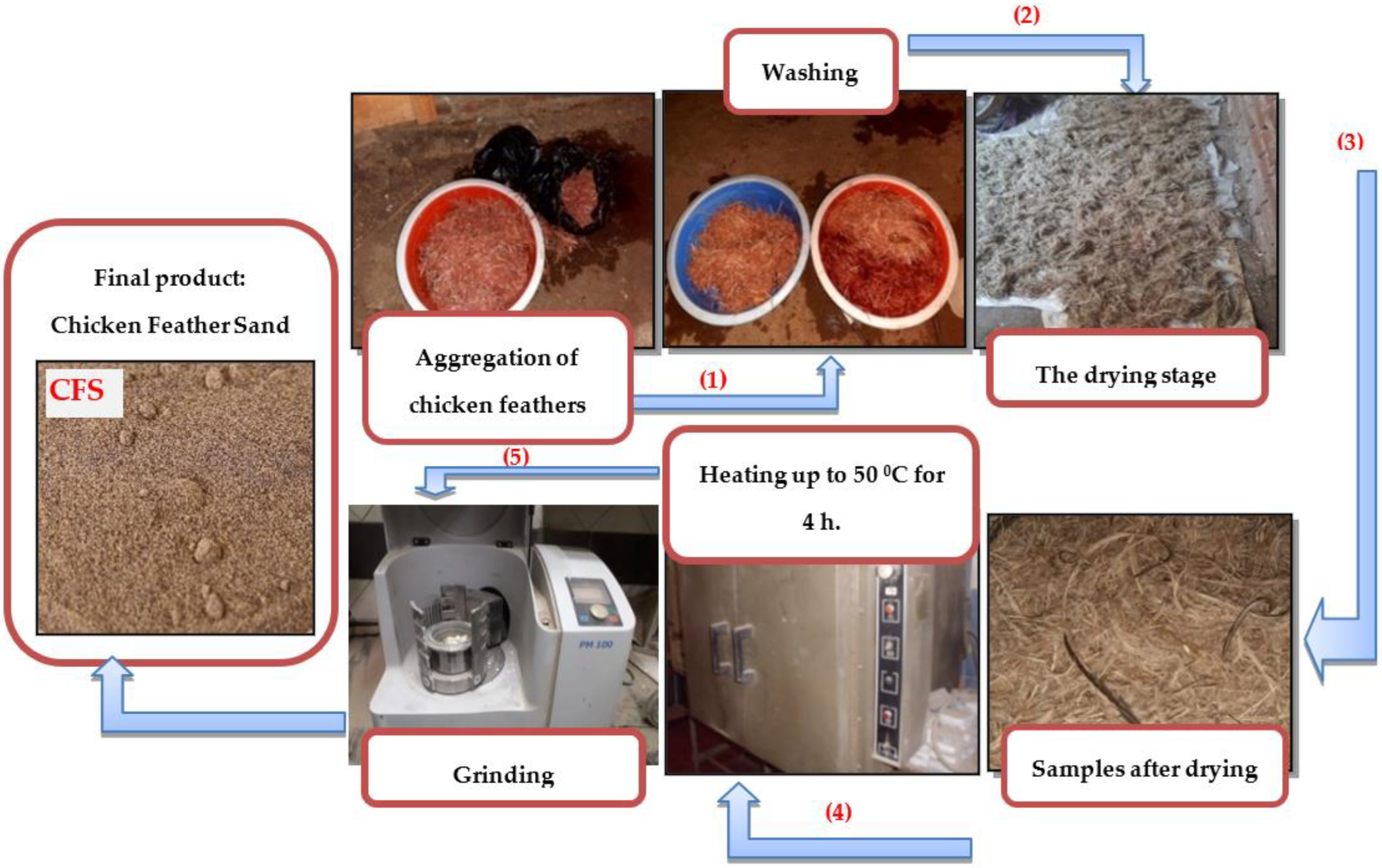
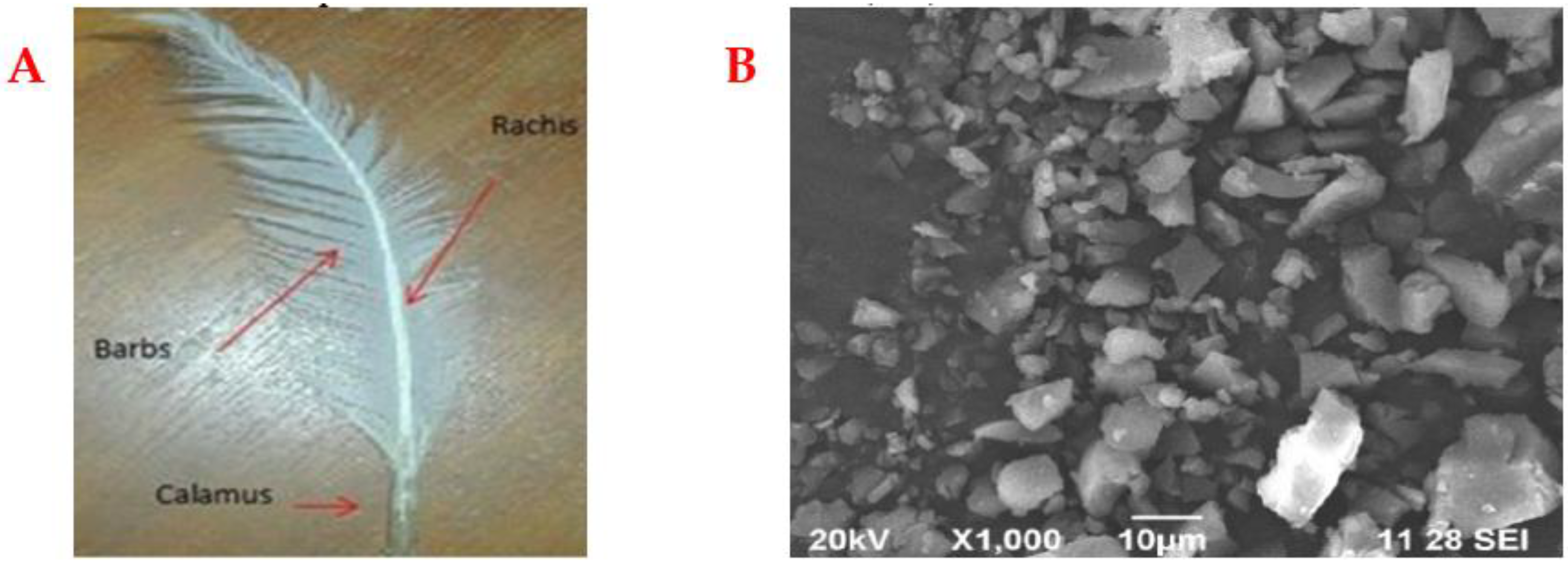

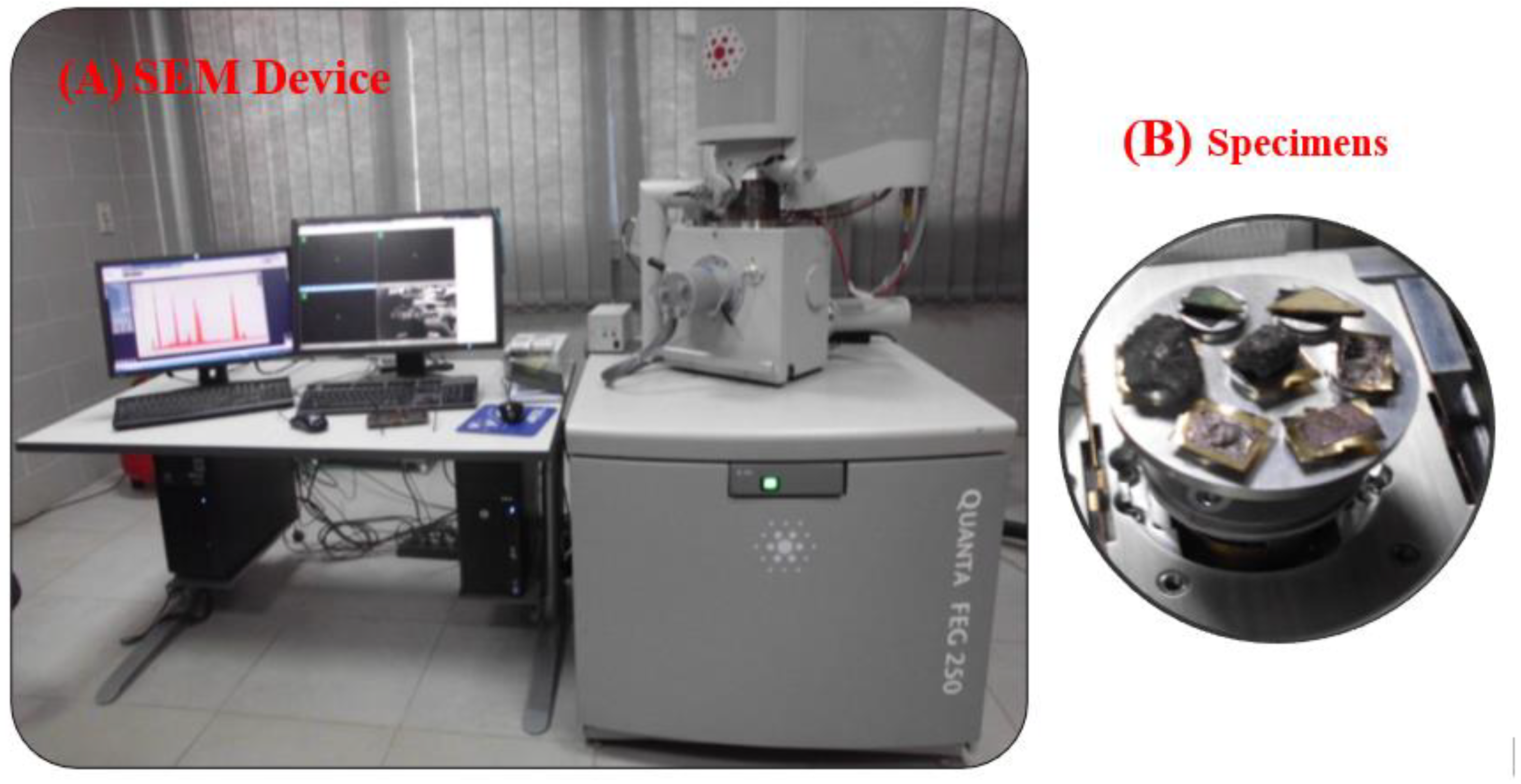

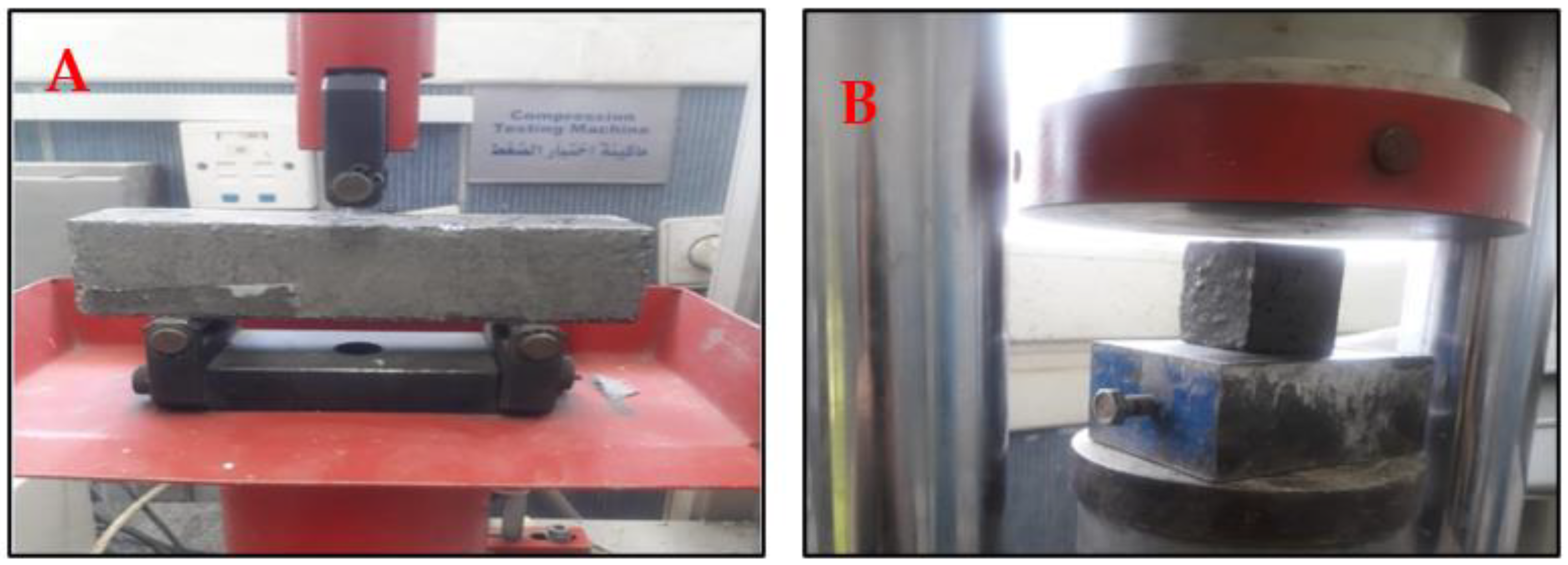
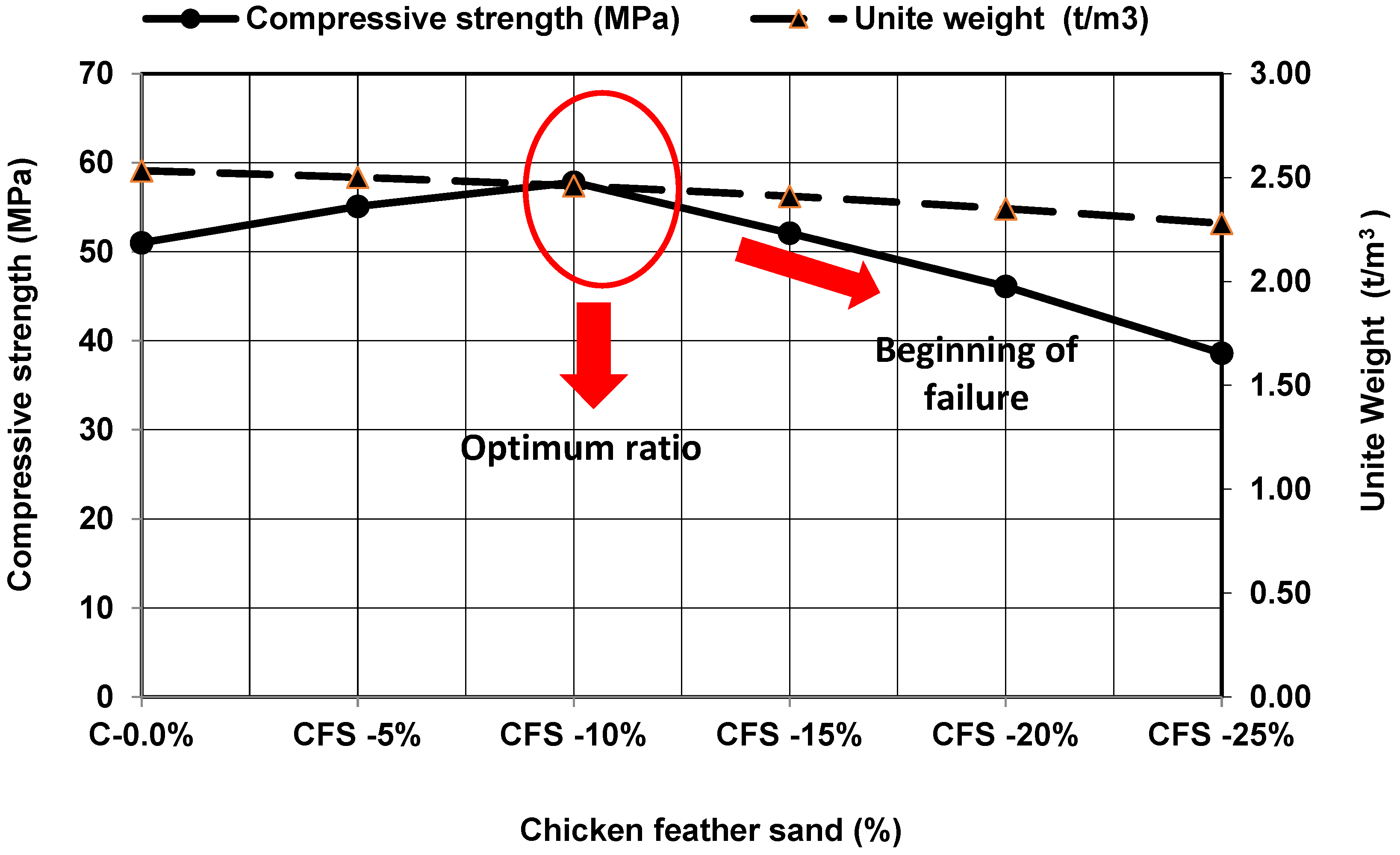

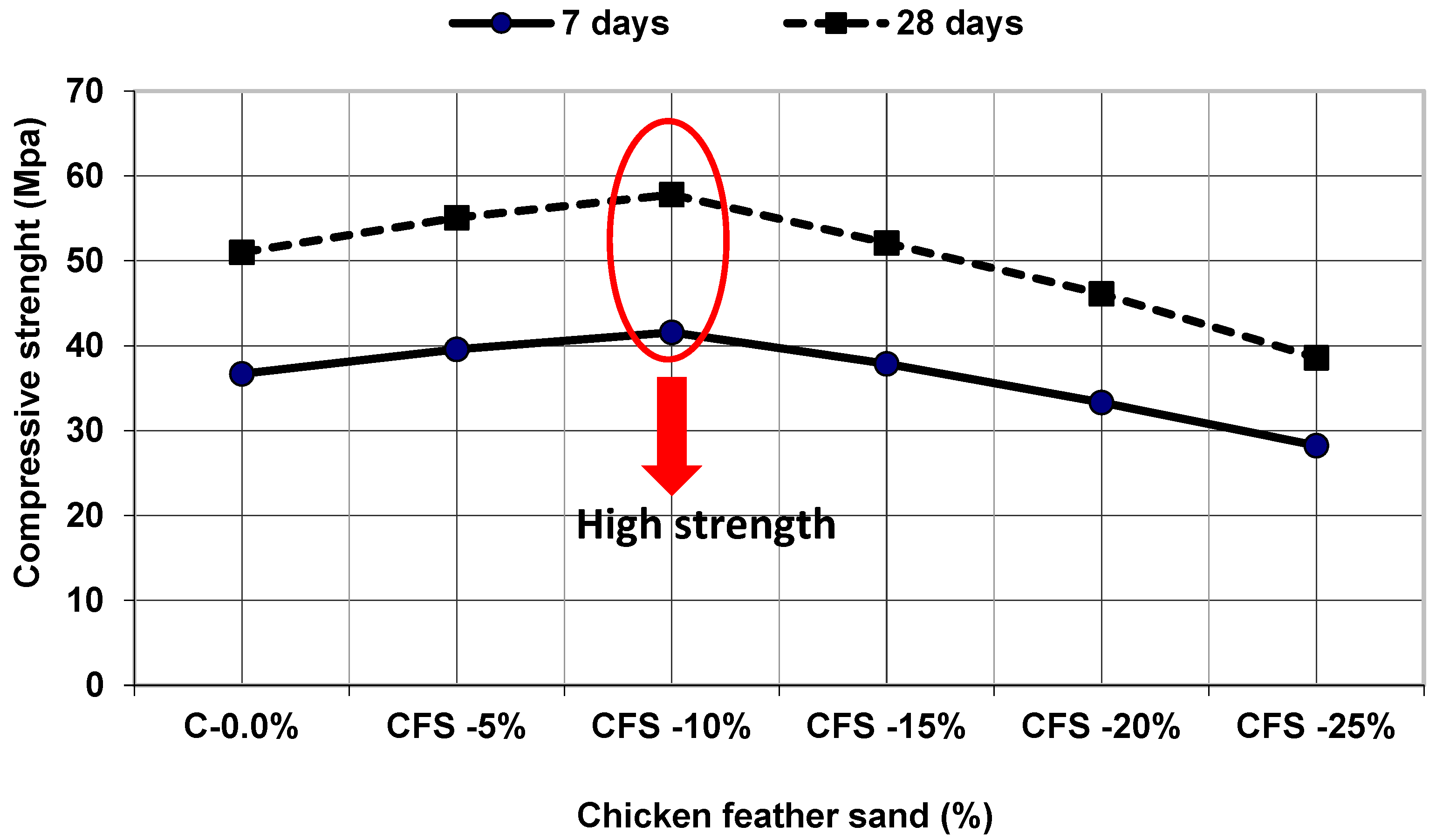
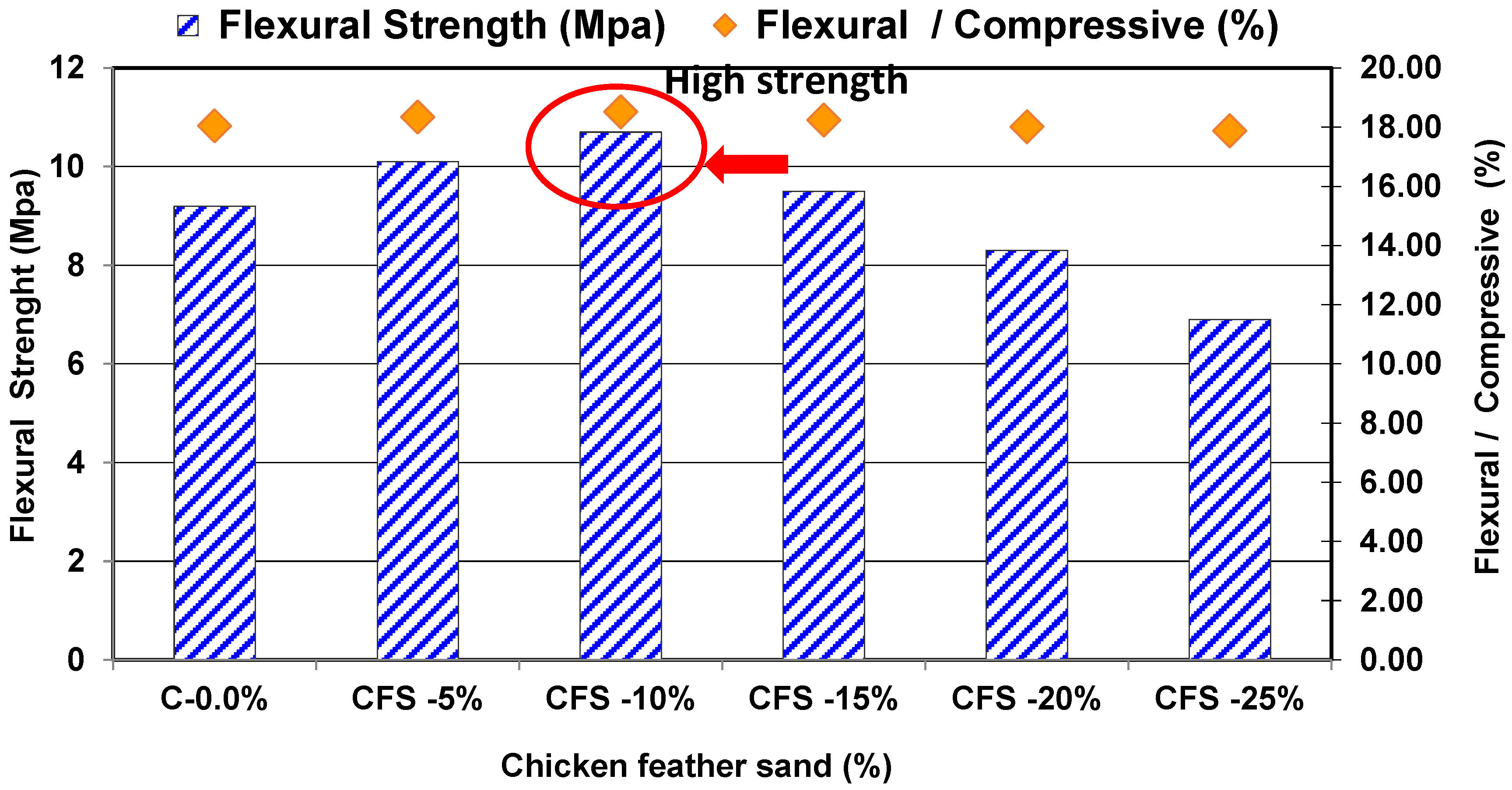
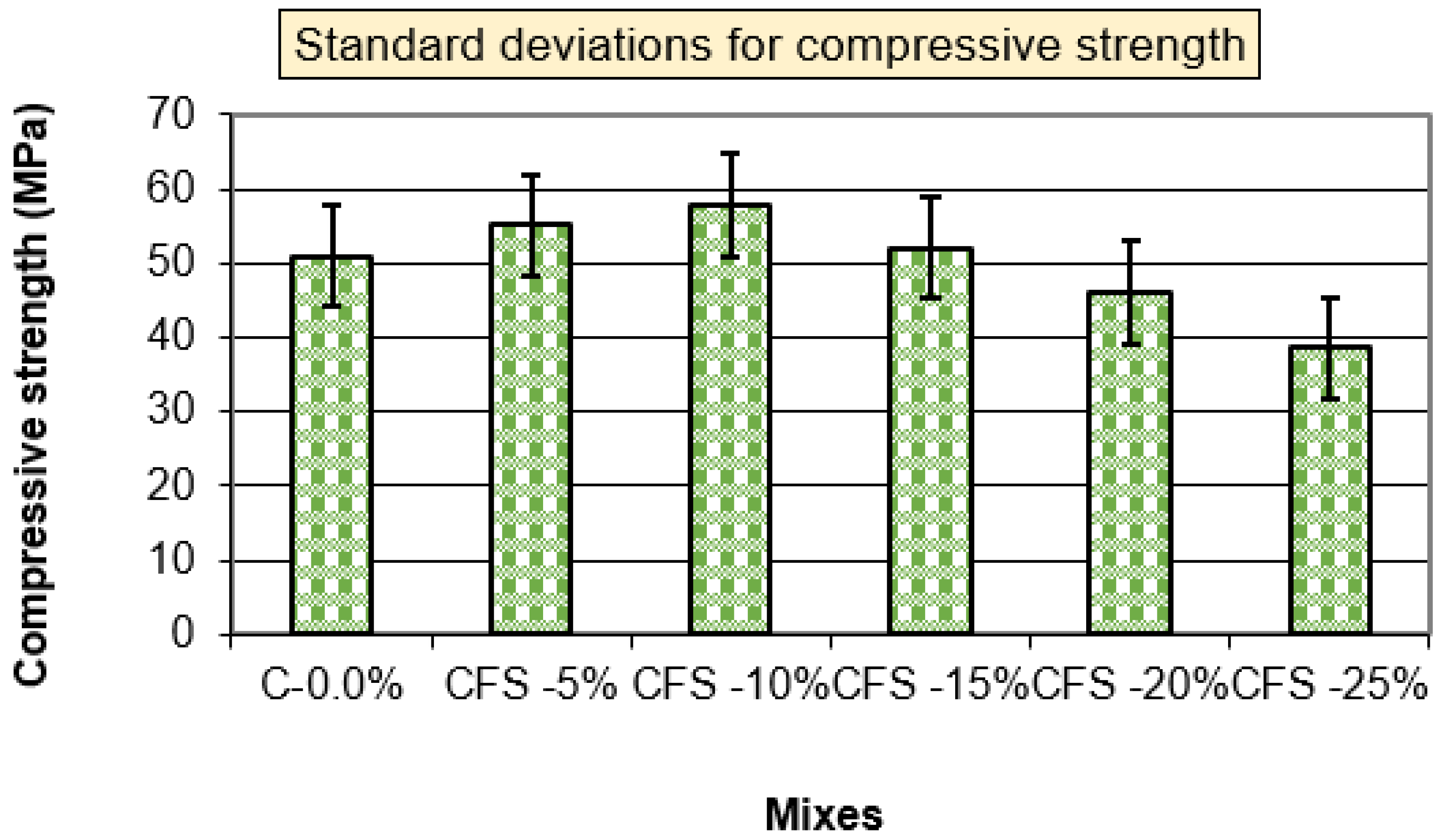

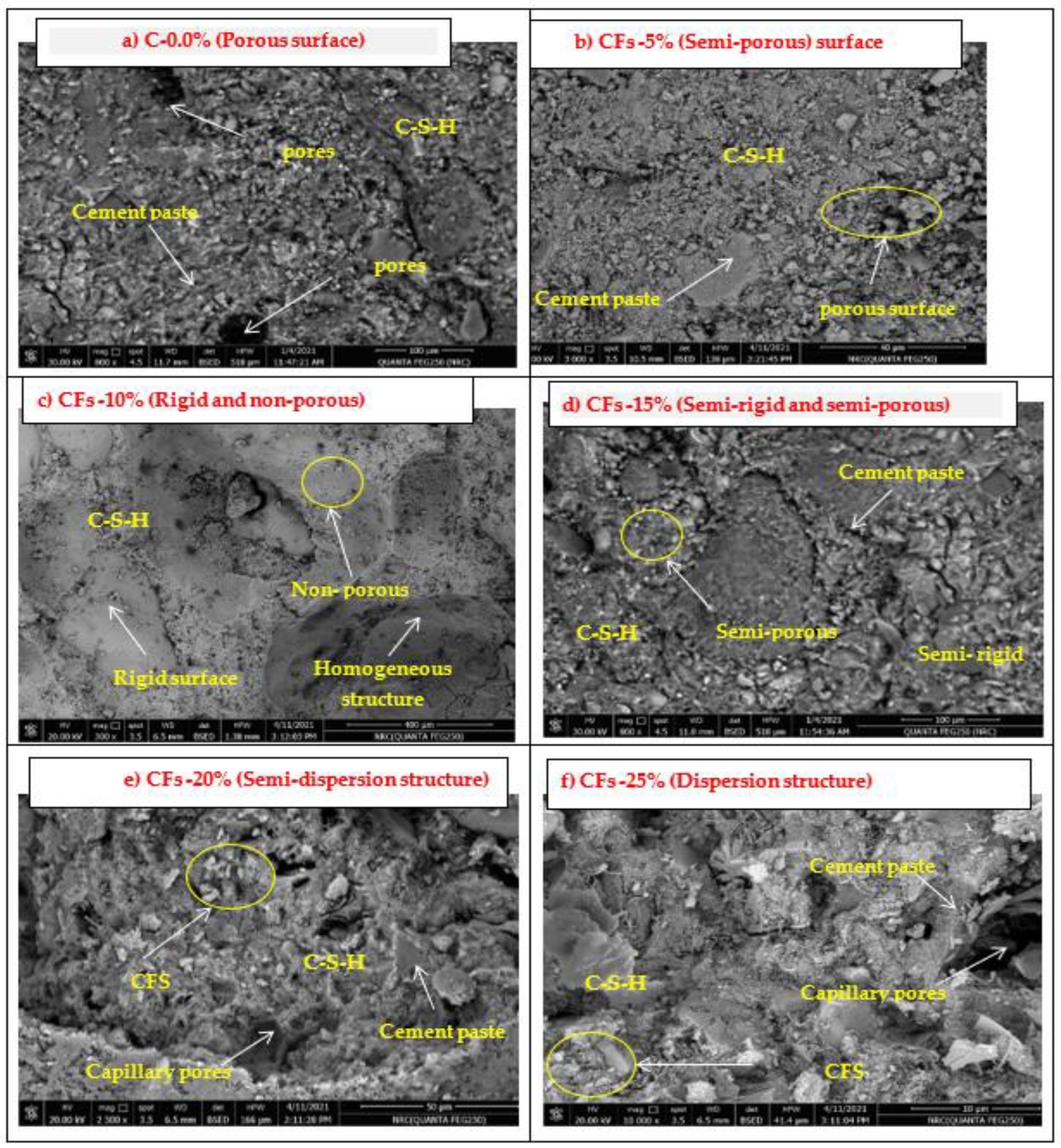

| Physical Properties | Chicken Feather (CF) |
|---|---|
| Elongation at Break (%) | 1–6 |
| Modulus of elastic (G/tex) | 3.96 |
| Moisture Content (%) | 10–11 |
| Moisture Regain (%) | 12–12.35 |
| Density (t/m3) | 1.12 |
| Elements | K | Mg | Ca | Na | P | S | Fe | Mn | Zn | Cu |
|---|---|---|---|---|---|---|---|---|---|---|
| CFP (g 100 g−1) | 12.52 | 5.31 | 6.58 | 7.96 | 2.16 | 0.04 | 0.95 | 0.62 | 0.77 | 0.22 |
| Sample | Cement | Sand | CFS | Water |
|---|---|---|---|---|
| C-0.0% | 528.0 | 1584.0 | 0 | 211.20 |
| CFS-5% | 528.0 | 501.6 | 26.4 | 211.20 |
| CFS-10% | 528.0 | 475.2 | 52.8 | 211.20 |
| CFS-15% | 528.0 | 448.8 | 79.2 | 211.20 |
| CFS-20% | 528.0 | 422.4 | 105.6 | 211.20 |
| CFS-25% | 528.0 | 396.0 | 132.0 | 211.20 |
| Sample | Consistency (mm) | Unit Weight t/m3 | Water Absorption (%) | Fcu at 7 Days (MPa) | Fcu at 28 Days (MPa) | Flexural Strength (MPa) |
|---|---|---|---|---|---|---|
| C-0.0% | 152 | 2.53 | 7.2 | 36.7 | 51.0 | 9.2 |
| CFS-5% | 147 | 2.50 | 8.2 | 39.6 | 55.1 | 10.1 |
| CFS-10% | 141 | 2.46 | 9.4 | 41.6 | 57.8 | 10.7 |
| CFS-15% | 134 | 2.41 | 10.6 | 37.9 | 52.1 | 9.5 |
| CFS-20% | 126 | 2.35 | 11.8 | 33.3 | 46.1 | 8.3 |
| CFS-25% | 117 | 2.28 | 12.9 | 28.2 | 38.6 | 6.9 |
Disclaimer/Publisher’s Note: The statements, opinions and data contained in all publications are solely those of the individual author(s) and contributor(s) and not of MDPI and/or the editor(s). MDPI and/or the editor(s) disclaim responsibility for any injury to people or property resulting from any ideas, methods, instructions or products referred to in the content. |
© 2023 by the authors. Licensee MDPI, Basel, Switzerland. This article is an open access article distributed under the terms and conditions of the Creative Commons Attribution (CC BY) license (https://creativecommons.org/licenses/by/4.0/).
Share and Cite
Defalla Abdel Hafez, R.; Hadzima-Nyarko, M.; Ahmed, S.M.; Tayeh, B.A. Recycled Chicken Feather Sand as a Partial Replacement for Natural Sand for Producing Eco-Friendly Mortar. Buildings 2023, 13, 421. https://doi.org/10.3390/buildings13020421
Defalla Abdel Hafez R, Hadzima-Nyarko M, Ahmed SM, Tayeh BA. Recycled Chicken Feather Sand as a Partial Replacement for Natural Sand for Producing Eco-Friendly Mortar. Buildings. 2023; 13(2):421. https://doi.org/10.3390/buildings13020421
Chicago/Turabian StyleDefalla Abdel Hafez, Radwa, Marijana Hadzima-Nyarko, Samir M. Ahmed, and Bassam A. Tayeh. 2023. "Recycled Chicken Feather Sand as a Partial Replacement for Natural Sand for Producing Eco-Friendly Mortar" Buildings 13, no. 2: 421. https://doi.org/10.3390/buildings13020421
APA StyleDefalla Abdel Hafez, R., Hadzima-Nyarko, M., Ahmed, S. M., & Tayeh, B. A. (2023). Recycled Chicken Feather Sand as a Partial Replacement for Natural Sand for Producing Eco-Friendly Mortar. Buildings, 13(2), 421. https://doi.org/10.3390/buildings13020421








